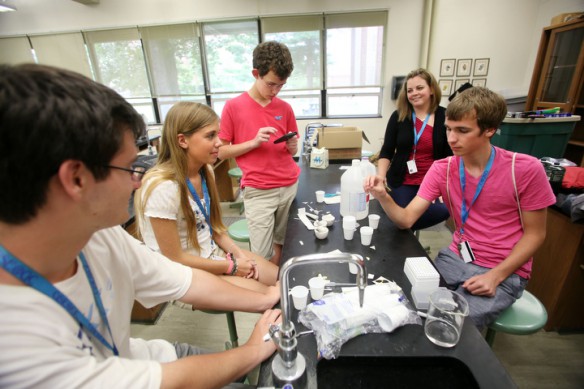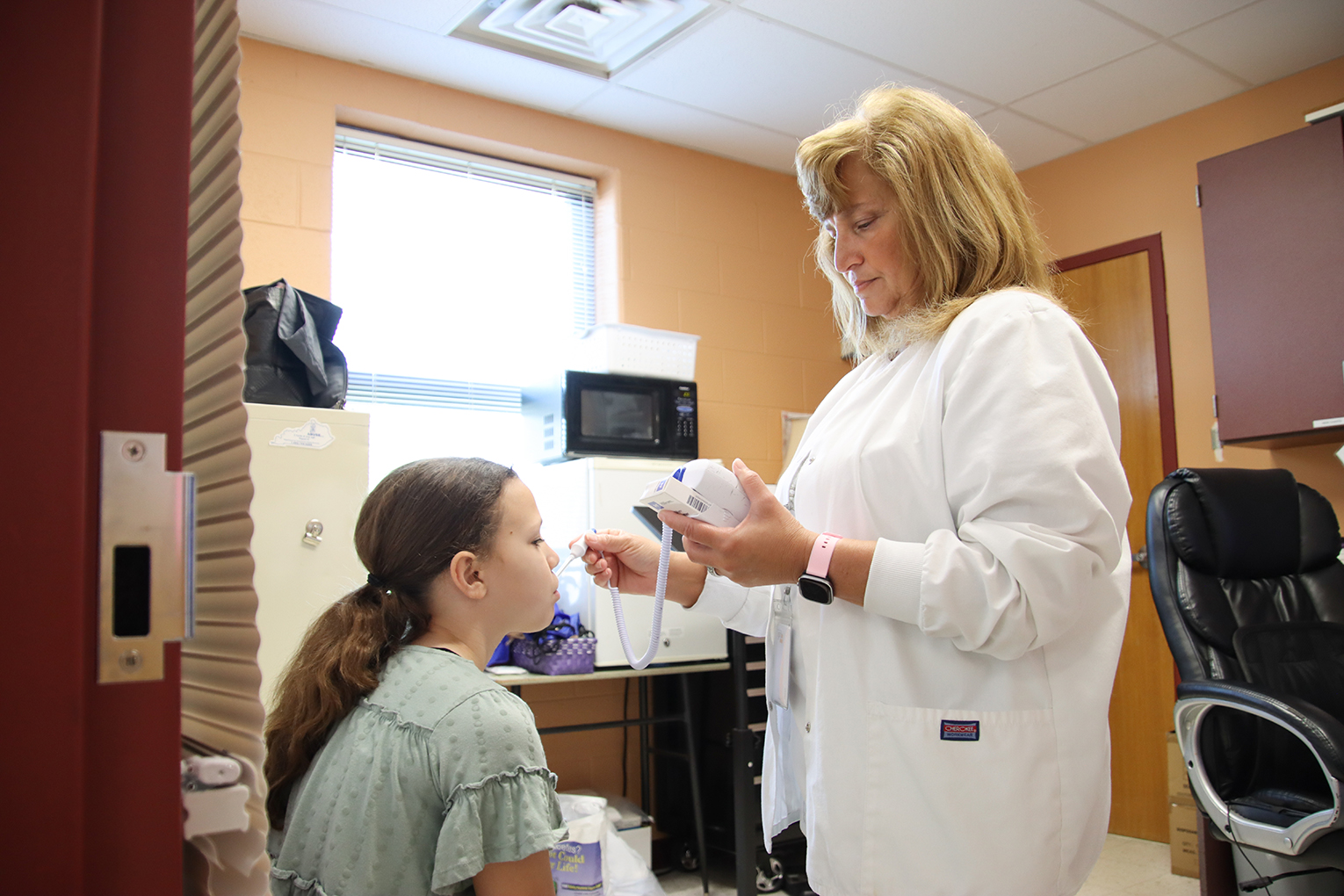
Crawford Middle School (Fayette County) teacher Casey Bayne, second from right, talks with Trinity High School (Jefferson County private) junior Ben Baughman, Hopkinsville High School (Christian County) junior Peyton Hughes, sophomore David Pyle and junior Read Hughes about the results of the product they created during the Governor’s School for Entrepreneurs at Georgetown College. Photo by Amy Wallot, June 20, 2013
By Susan Riddell
susan.riddell@education.ky.gov
Brad Armstrong really wants his teachers to see him for more than his mowing and landscaping business.
“They see me as the lawn care kid,” said Armstrong, who is getting ready to start his senior year at Conner High School (Boone County) and has owned and operated his business since he was 12 years old. “I want them to see me as a successful businessperson who is interested in much more than mowing yards.”
After participating in the Governor’s School for Entrepreneurs (GSE), Armstrong feels he is better equipped with the tools to make that a reality, and he’s on a strong path toward college and career readiness.
Nearly 50 Kentucky high school students recently wrapped up participation in the three-week inaugural GSE for rising 10 through12-grade students. While there, students worked in teams, developing a product.
Through a variety of speakers (Papa John’s president John Schnatter, for one) and field trips, GSE entrepreneurs also learned about production; selling and marketing their product; investment and funding strategies; and how to develop confidence to use when making presentations.
Selection for GSE was competitive with students submitting a short video discussing a viable product they’d like to produce. Academic grades weren’t a consideration in the process, according to GSE Executive Director Laurie Daugherty. Creativity and being able to develop amazing ideas did, however, factor into selection.
Some students had a lot of business experience while others had minimal experience. Some knew how to code software while others didn’t.
Armstrong heard about GSE from both a teacher and his assistant principal, Jason Shearer.
He already had the basic business know-how and some leadership skills down, but GSE taught him about liability issues and other facets of business he hadn’t faced with his mowing business, which has several employees and services multiple commercial clients. Casey Bayne, who teaches 6th grade social studies and 8th grade science at Crawford Middle School (Fayette County), coached Armstrong’s team.
Bayne signed up to work at GSE because she wanted to expand her knowledge of business models and practices not only for her classroom but also for her entrepreneurship club at Crawford Middle.
“Our emphasis at GSE is to help the learners develop a set of skills that they can apply to any idea that they have in the future,” Bayne said.
Much like Armstrong wants his teachers to see him as more of a businessman, Bayne said teachers who greet GSE entrepreneurs back at school this fall will notice they have changed.
“I think teachers who have these kids in class should be prepared for them to question everything,” Bayne said. “That’s something we’ve really emphasized during the program. They will pose more questions than before, and they won’t stop until they’ve exhausted every aspect of a problem or every option to a solution.
“That’s the mindset they’ll need as a successful entrepreneur.”
Bayne modeled the question-everything concept for entrepreneurs during her time as a coach.
“If a team becomes too comfortable in their idea, I force them to think about the hard questions,” she said. “If the entrepreneurs cannot come up with a validated response, I challenge them to find a way to get the questions answered. Sometimes the answer might be market research. Other times, it is getting out of the building and doing some interviewing, or perhaps they need to put a minimum viable product on the market and see if anyone is interested.”
As some entrepreneurs learned at GSE, a product isn’t always viable.
Armstrong’s team reached that point several days into the program. His team wanted to develop an orange tire tape that warns a car owner when a tire has lost too much tread and has become dangerous.
Before long, team members realized their product already had been developed, and they needed to pivot, a term entrepreneurs use to describe using what they have learned from past successes and failures and applying these insights in new areas or in taking a completely new direction..
Armstrong’s team eventually settled on a product they hoped to develop into a student-friendly, school-based application.
Some teams worked on a product that one or more of its members presented in their application video. Some services, like Joe Richardson’s TriPhonia business, are already viable or part of viable businesses.
Several entrepreneurs plan to stay in touch with team members and pursue making their product or service viable in the real world.
Daugherty also said that students who continue developing their products will receive resources to do so, including being connected with local business people from their area who will serve as mentors.
She was very pleased with how students worked and performed during GSE, and Daugherty said she expects more of the same from next year’s entrepreneurs.
Kentucky teachers should be on the lookout for students “who are motivated, innovative and flexible” and may be interested in participating in next year’s GSE, Bayne said. “At Crawford Middle, these students will likely be in the entrepreneurship club, so I will promote it from within that program.”
Bayne also recommends other teachers consider coaching at GSE next year.
The GSE approach of having entrepreneurs value both independent learning and teamwork helped her, too, she said, and the experience will help her be a more effective teacher.
“We provide the resources, create an environment for learning and become the facilitators of learning rather than the teachers,” she said. “As a social studies and science teacher, this is what I strive for in the classroom every day. GSE is giving me new skills, strategies and insights that I can effectively take back to my classroom in the fall.
“I definitely intend to apply most of what I have experienced here at GSE in the classroom next year,” Bayne added. “With each new idea (the young entrepreneurs become) better and better at applying the concepts that they have learned along the way to prove or disprove product viability with the business model canvas. This relevant application of knowledge is an indicator of true learning. The students that I work with in the coming school year deserve this kind of learning.”
MORE INFO …
Laurie Daugherty, lcdaugherty@kstc.com, (859) 246-3225











Leave A Comment